Essay: Management, Leadership, and Social Responsibility in Enterprise
VerifiedAdded on 2022/09/08
|6
|1463
|18
Essay
AI Summary
This essay delves into the distinctions between management and leadership, crucial concepts for enterprise leaders. It explores how these roles differ, examining the functions, responsibilities, and approaches of managers and leaders, drawing on the work of Bonau, Kotterman, Maccoby, Ready, and Simonet & Tett. The essay analyzes the role of enterprise leaders in fostering social responsibility, investigating how leaders can learn and implement socially responsible practices within their organizations. It considers the importance of ethical considerations, stakeholder engagement, and sustainable development, providing a comprehensive understanding of effective leadership in contemporary business environments. The essay highlights the significance of balancing organizational goals with ethical considerations, emphasizing the importance of leaders' ability to inspire and guide their teams towards achieving both business success and positive societal impact.
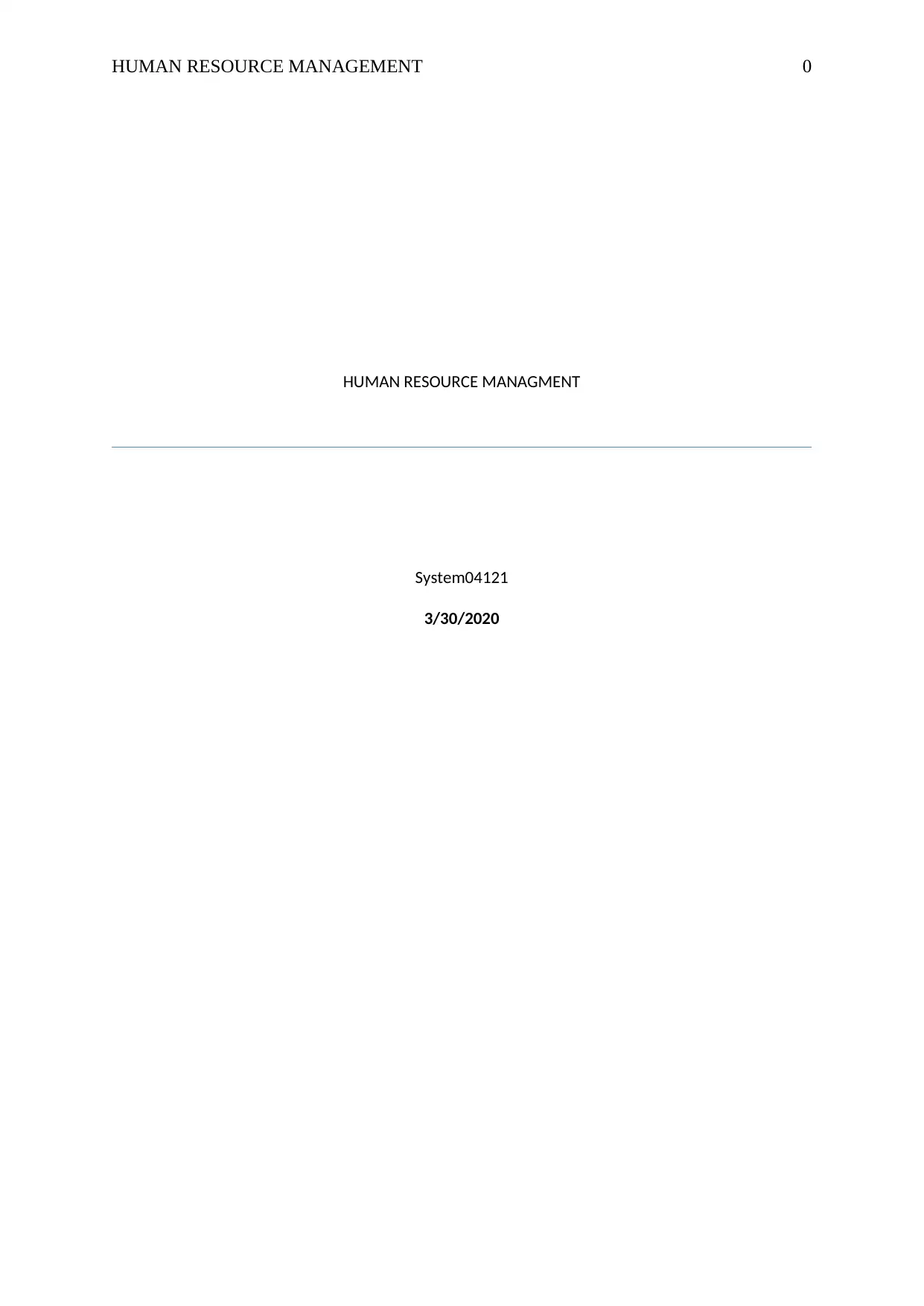
HUMAN RESOURCE MANAGEMENT 0
HUMAN RESOURCE MANAGMENT
System04121
3/30/2020
HUMAN RESOURCE MANAGMENT
System04121
3/30/2020
Paraphrase This Document
Need a fresh take? Get an instant paraphrase of this document with our AI Paraphraser
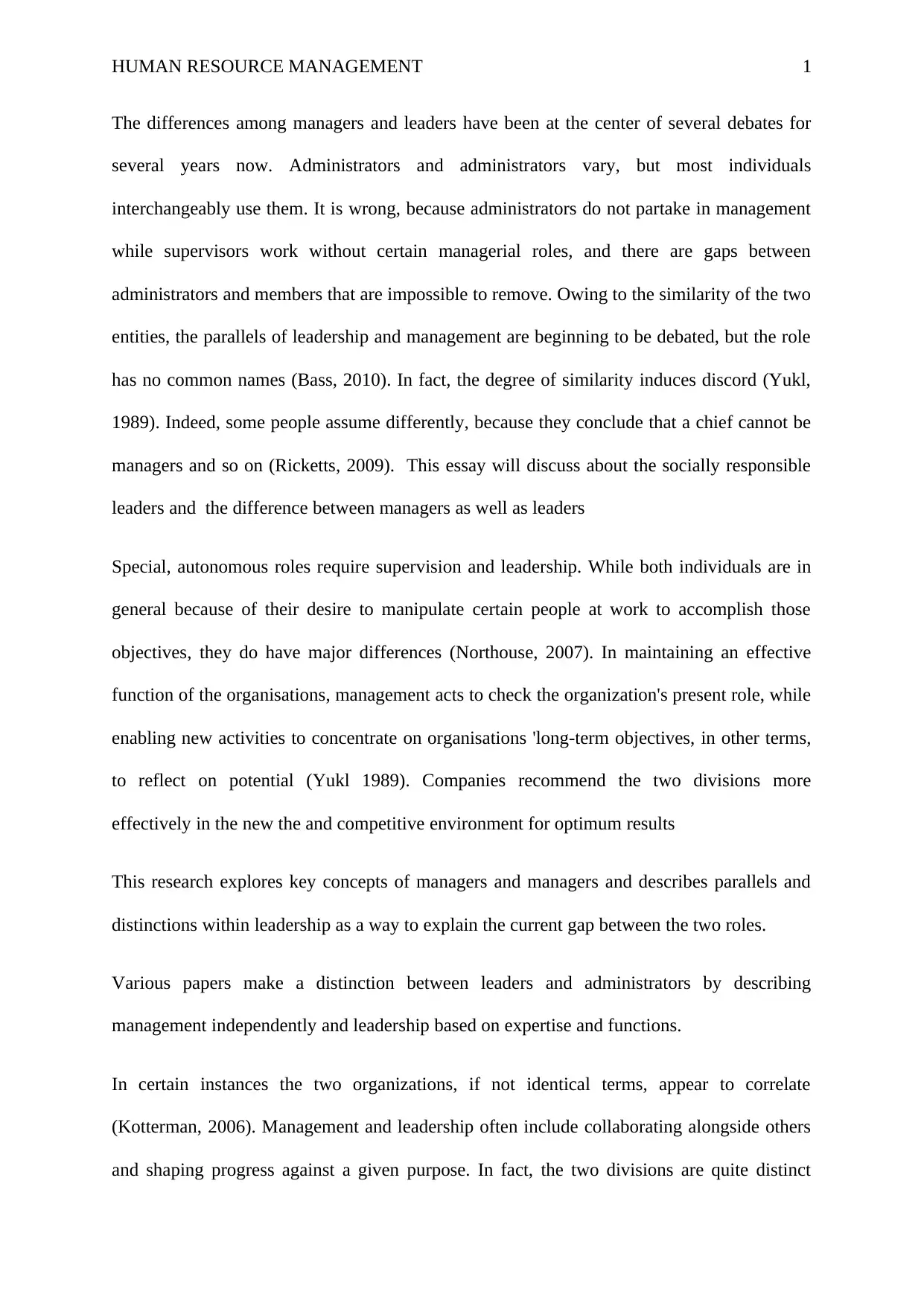
HUMAN RESOURCE MANAGEMENT 1
The differences among managers and leaders have been at the center of several debates for
several years now. Administrators and administrators vary, but most individuals
interchangeably use them. It is wrong, because administrators do not partake in management
while supervisors work without certain managerial roles, and there are gaps between
administrators and members that are impossible to remove. Owing to the similarity of the two
entities, the parallels of leadership and management are beginning to be debated, but the role
has no common names (Bass, 2010). In fact, the degree of similarity induces discord (Yukl,
1989). Indeed, some people assume differently, because they conclude that a chief cannot be
managers and so on (Ricketts, 2009). This essay will discuss about the socially responsible
leaders and the difference between managers as well as leaders
Special, autonomous roles require supervision and leadership. While both individuals are in
general because of their desire to manipulate certain people at work to accomplish those
objectives, they do have major differences (Northouse, 2007). In maintaining an effective
function of the organisations, management acts to check the organization's present role, while
enabling new activities to concentrate on organisations 'long-term objectives, in other terms,
to reflect on potential (Yukl 1989). Companies recommend the two divisions more
effectively in the new the and competitive environment for optimum results
This research explores key concepts of managers and managers and describes parallels and
distinctions within leadership as a way to explain the current gap between the two roles.
Various papers make a distinction between leaders and administrators by describing
management independently and leadership based on expertise and functions.
In certain instances the two organizations, if not identical terms, appear to correlate
(Kotterman, 2006). Management and leadership often include collaborating alongside others
and shaping progress against a given purpose. In fact, the two divisions are quite distinct
The differences among managers and leaders have been at the center of several debates for
several years now. Administrators and administrators vary, but most individuals
interchangeably use them. It is wrong, because administrators do not partake in management
while supervisors work without certain managerial roles, and there are gaps between
administrators and members that are impossible to remove. Owing to the similarity of the two
entities, the parallels of leadership and management are beginning to be debated, but the role
has no common names (Bass, 2010). In fact, the degree of similarity induces discord (Yukl,
1989). Indeed, some people assume differently, because they conclude that a chief cannot be
managers and so on (Ricketts, 2009). This essay will discuss about the socially responsible
leaders and the difference between managers as well as leaders
Special, autonomous roles require supervision and leadership. While both individuals are in
general because of their desire to manipulate certain people at work to accomplish those
objectives, they do have major differences (Northouse, 2007). In maintaining an effective
function of the organisations, management acts to check the organization's present role, while
enabling new activities to concentrate on organisations 'long-term objectives, in other terms,
to reflect on potential (Yukl 1989). Companies recommend the two divisions more
effectively in the new the and competitive environment for optimum results
This research explores key concepts of managers and managers and describes parallels and
distinctions within leadership as a way to explain the current gap between the two roles.
Various papers make a distinction between leaders and administrators by describing
management independently and leadership based on expertise and functions.
In certain instances the two organizations, if not identical terms, appear to correlate
(Kotterman, 2006). Management and leadership often include collaborating alongside others
and shaping progress against a given purpose. In fact, the two divisions are quite distinct
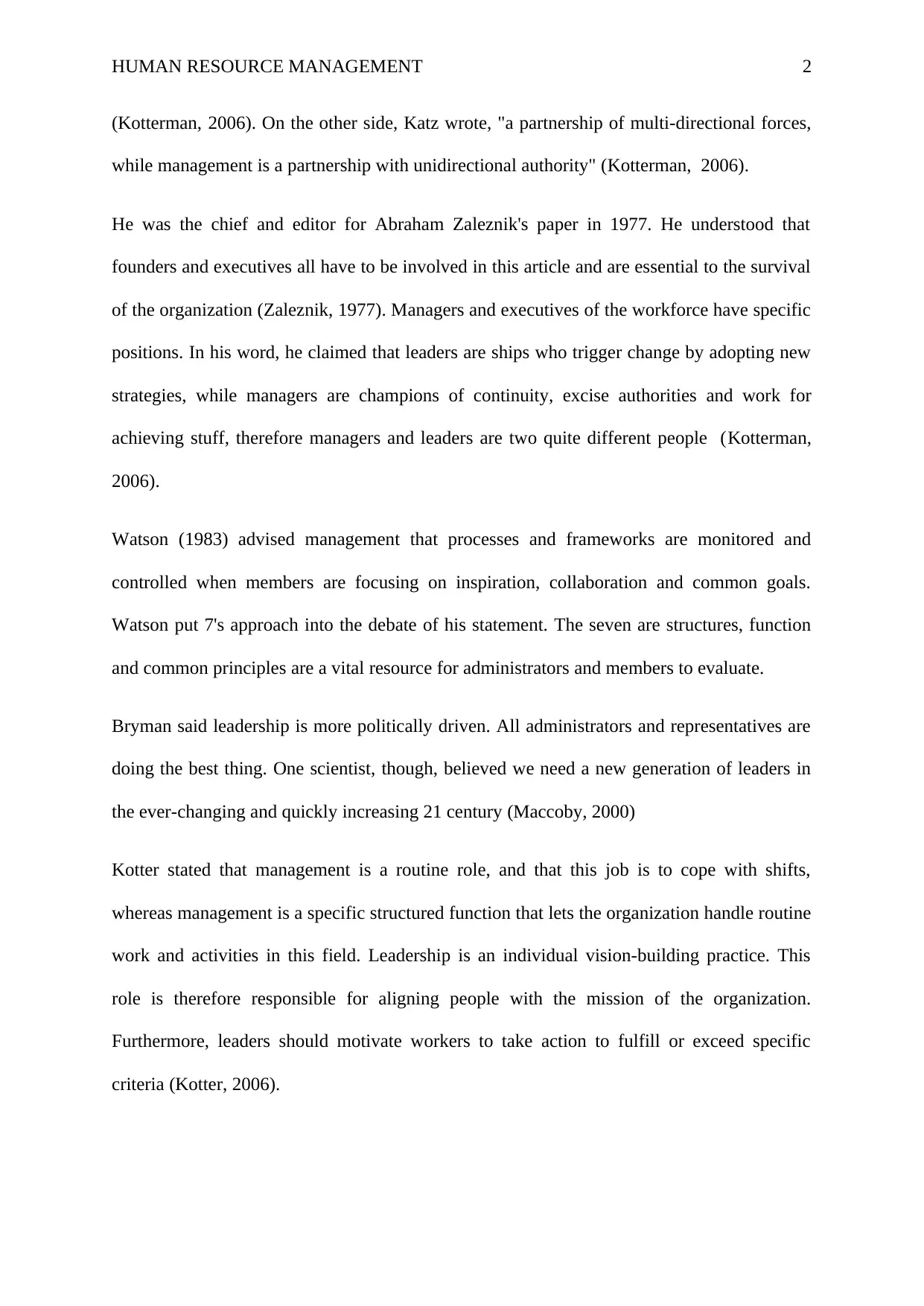
HUMAN RESOURCE MANAGEMENT 2
(Kotterman, 2006). On the other side, Katz wrote, "a partnership of multi-directional forces,
while management is a partnership with unidirectional authority" (Kotterman, 2006).
He was the chief and editor for Abraham Zaleznik's paper in 1977. He understood that
founders and executives all have to be involved in this article and are essential to the survival
of the organization (Zaleznik, 1977). Managers and executives of the workforce have specific
positions. In his word, he claimed that leaders are ships who trigger change by adopting new
strategies, while managers are champions of continuity, excise authorities and work for
achieving stuff, therefore managers and leaders are two quite different people (Kotterman,
2006).
Watson (1983) advised management that processes and frameworks are monitored and
controlled when members are focusing on inspiration, collaboration and common goals.
Watson put 7's approach into the debate of his statement. The seven are structures, function
and common principles are a vital resource for administrators and members to evaluate.
Bryman said leadership is more politically driven. All administrators and representatives are
doing the best thing. One scientist, though, believed we need a new generation of leaders in
the ever-changing and quickly increasing 21 century (Maccoby, 2000)
Kotter stated that management is a routine role, and that this job is to cope with shifts,
whereas management is a specific structured function that lets the organization handle routine
work and activities in this field. Leadership is an individual vision-building practice. This
role is therefore responsible for aligning people with the mission of the organization.
Furthermore, leaders should motivate workers to take action to fulfill or exceed specific
criteria (Kotter, 2006).
(Kotterman, 2006). On the other side, Katz wrote, "a partnership of multi-directional forces,
while management is a partnership with unidirectional authority" (Kotterman, 2006).
He was the chief and editor for Abraham Zaleznik's paper in 1977. He understood that
founders and executives all have to be involved in this article and are essential to the survival
of the organization (Zaleznik, 1977). Managers and executives of the workforce have specific
positions. In his word, he claimed that leaders are ships who trigger change by adopting new
strategies, while managers are champions of continuity, excise authorities and work for
achieving stuff, therefore managers and leaders are two quite different people (Kotterman,
2006).
Watson (1983) advised management that processes and frameworks are monitored and
controlled when members are focusing on inspiration, collaboration and common goals.
Watson put 7's approach into the debate of his statement. The seven are structures, function
and common principles are a vital resource for administrators and members to evaluate.
Bryman said leadership is more politically driven. All administrators and representatives are
doing the best thing. One scientist, though, believed we need a new generation of leaders in
the ever-changing and quickly increasing 21 century (Maccoby, 2000)
Kotter stated that management is a routine role, and that this job is to cope with shifts,
whereas management is a specific structured function that lets the organization handle routine
work and activities in this field. Leadership is an individual vision-building practice. This
role is therefore responsible for aligning people with the mission of the organization.
Furthermore, leaders should motivate workers to take action to fulfill or exceed specific
criteria (Kotter, 2006).
⊘ This is a preview!⊘
Do you want full access?
Subscribe today to unlock all pages.

Trusted by 1+ million students worldwide
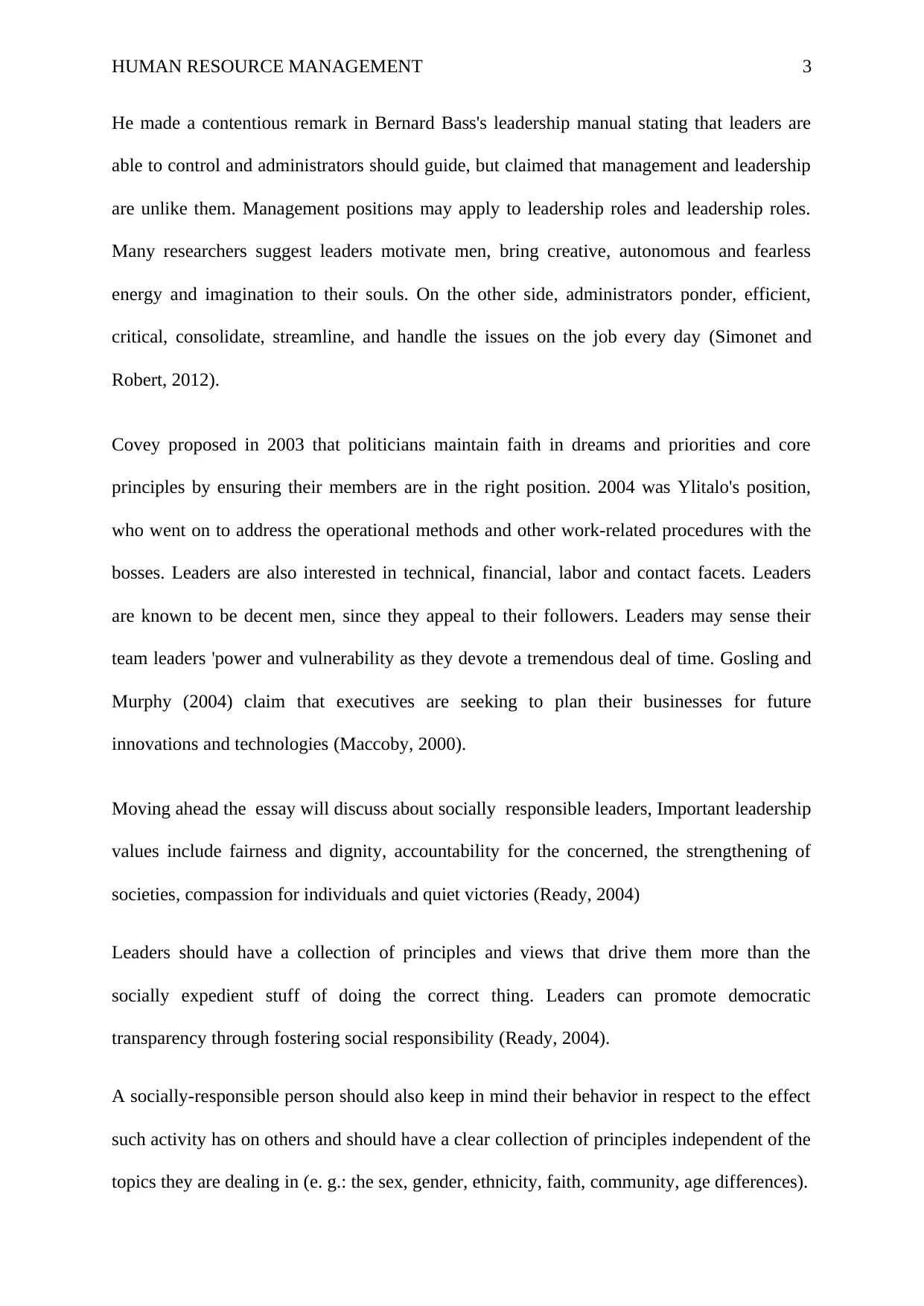
HUMAN RESOURCE MANAGEMENT 3
He made a contentious remark in Bernard Bass's leadership manual stating that leaders are
able to control and administrators should guide, but claimed that management and leadership
are unlike them. Management positions may apply to leadership roles and leadership roles.
Many researchers suggest leaders motivate men, bring creative, autonomous and fearless
energy and imagination to their souls. On the other side, administrators ponder, efficient,
critical, consolidate, streamline, and handle the issues on the job every day (Simonet and
Robert, 2012).
Covey proposed in 2003 that politicians maintain faith in dreams and priorities and core
principles by ensuring their members are in the right position. 2004 was Ylitalo's position,
who went on to address the operational methods and other work-related procedures with the
bosses. Leaders are also interested in technical, financial, labor and contact facets. Leaders
are known to be decent men, since they appeal to their followers. Leaders may sense their
team leaders 'power and vulnerability as they devote a tremendous deal of time. Gosling and
Murphy (2004) claim that executives are seeking to plan their businesses for future
innovations and technologies (Maccoby, 2000).
Moving ahead the essay will discuss about socially responsible leaders, Important leadership
values include fairness and dignity, accountability for the concerned, the strengthening of
societies, compassion for individuals and quiet victories (Ready, 2004)
Leaders should have a collection of principles and views that drive them more than the
socially expedient stuff of doing the correct thing. Leaders can promote democratic
transparency through fostering social responsibility (Ready, 2004).
A socially-responsible person should also keep in mind their behavior in respect to the effect
such activity has on others and should have a clear collection of principles independent of the
topics they are dealing in (e. g.: the sex, gender, ethnicity, faith, community, age differences).
He made a contentious remark in Bernard Bass's leadership manual stating that leaders are
able to control and administrators should guide, but claimed that management and leadership
are unlike them. Management positions may apply to leadership roles and leadership roles.
Many researchers suggest leaders motivate men, bring creative, autonomous and fearless
energy and imagination to their souls. On the other side, administrators ponder, efficient,
critical, consolidate, streamline, and handle the issues on the job every day (Simonet and
Robert, 2012).
Covey proposed in 2003 that politicians maintain faith in dreams and priorities and core
principles by ensuring their members are in the right position. 2004 was Ylitalo's position,
who went on to address the operational methods and other work-related procedures with the
bosses. Leaders are also interested in technical, financial, labor and contact facets. Leaders
are known to be decent men, since they appeal to their followers. Leaders may sense their
team leaders 'power and vulnerability as they devote a tremendous deal of time. Gosling and
Murphy (2004) claim that executives are seeking to plan their businesses for future
innovations and technologies (Maccoby, 2000).
Moving ahead the essay will discuss about socially responsible leaders, Important leadership
values include fairness and dignity, accountability for the concerned, the strengthening of
societies, compassion for individuals and quiet victories (Ready, 2004)
Leaders should have a collection of principles and views that drive them more than the
socially expedient stuff of doing the correct thing. Leaders can promote democratic
transparency through fostering social responsibility (Ready, 2004).
A socially-responsible person should also keep in mind their behavior in respect to the effect
such activity has on others and should have a clear collection of principles independent of the
topics they are dealing in (e. g.: the sex, gender, ethnicity, faith, community, age differences).
Paraphrase This Document
Need a fresh take? Get an instant paraphrase of this document with our AI Paraphraser
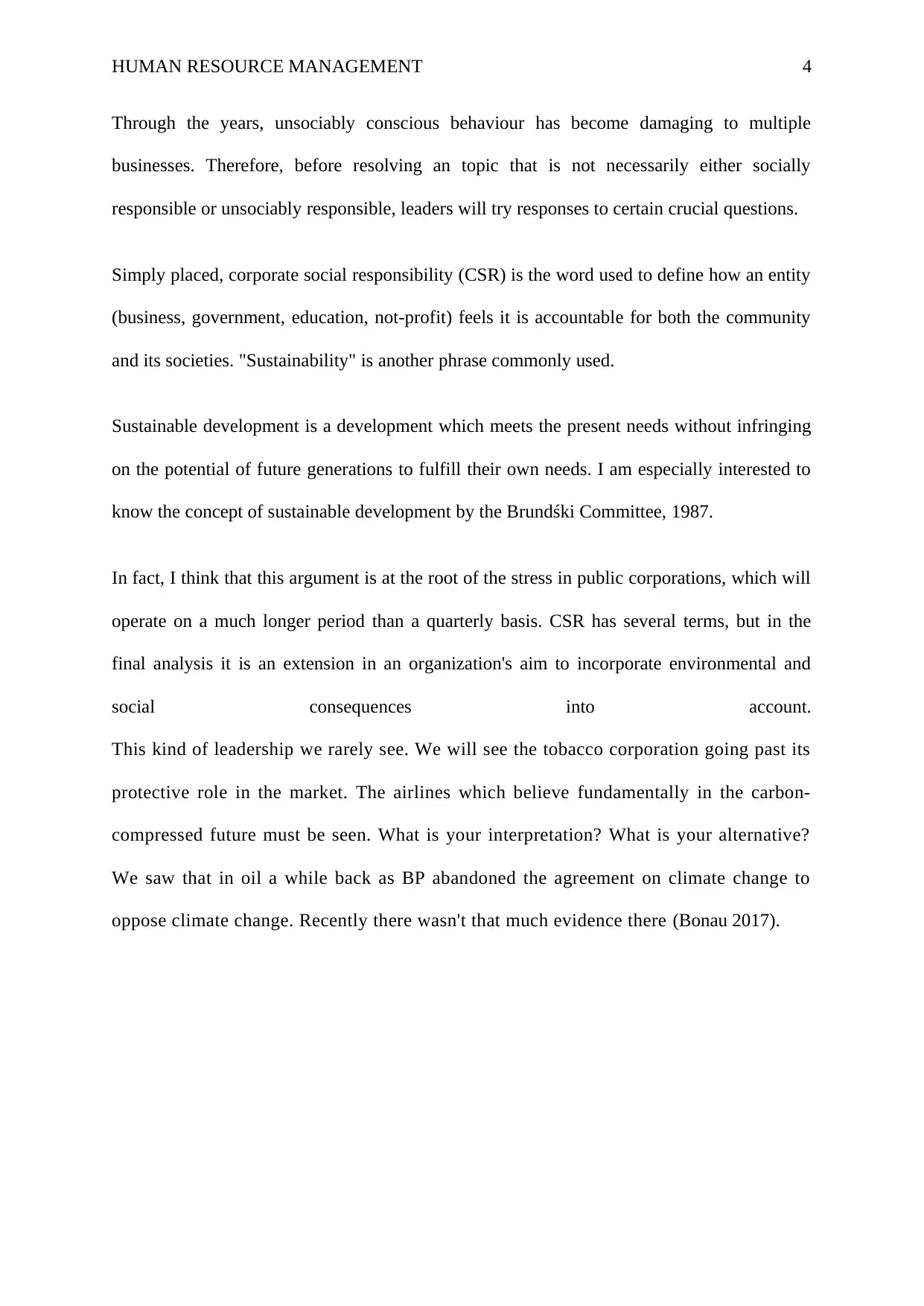
HUMAN RESOURCE MANAGEMENT 4
Through the years, unsociably conscious behaviour has become damaging to multiple
businesses. Therefore, before resolving an topic that is not necessarily either socially
responsible or unsociably responsible, leaders will try responses to certain crucial questions.
Simply placed, corporate social responsibility (CSR) is the word used to define how an entity
(business, government, education, not-profit) feels it is accountable for both the community
and its societies. "Sustainability" is another phrase commonly used.
Sustainable development is a development which meets the present needs without infringing
on the potential of future generations to fulfill their own needs. I am especially interested to
know the concept of sustainable development by the Brundśki Committee, 1987.
In fact, I think that this argument is at the root of the stress in public corporations, which will
operate on a much longer period than a quarterly basis. CSR has several terms, but in the
final analysis it is an extension in an organization's aim to incorporate environmental and
social consequences into account.
This kind of leadership we rarely see. We will see the tobacco corporation going past its
protective role in the market. The airlines which believe fundamentally in the carbon-
compressed future must be seen. What is your interpretation? What is your alternative?
We saw that in oil a while back as BP abandoned the agreement on climate change to
oppose climate change. Recently there wasn't that much evidence there (Bonau 2017).
Through the years, unsociably conscious behaviour has become damaging to multiple
businesses. Therefore, before resolving an topic that is not necessarily either socially
responsible or unsociably responsible, leaders will try responses to certain crucial questions.
Simply placed, corporate social responsibility (CSR) is the word used to define how an entity
(business, government, education, not-profit) feels it is accountable for both the community
and its societies. "Sustainability" is another phrase commonly used.
Sustainable development is a development which meets the present needs without infringing
on the potential of future generations to fulfill their own needs. I am especially interested to
know the concept of sustainable development by the Brundśki Committee, 1987.
In fact, I think that this argument is at the root of the stress in public corporations, which will
operate on a much longer period than a quarterly basis. CSR has several terms, but in the
final analysis it is an extension in an organization's aim to incorporate environmental and
social consequences into account.
This kind of leadership we rarely see. We will see the tobacco corporation going past its
protective role in the market. The airlines which believe fundamentally in the carbon-
compressed future must be seen. What is your interpretation? What is your alternative?
We saw that in oil a while back as BP abandoned the agreement on climate change to
oppose climate change. Recently there wasn't that much evidence there (Bonau 2017).
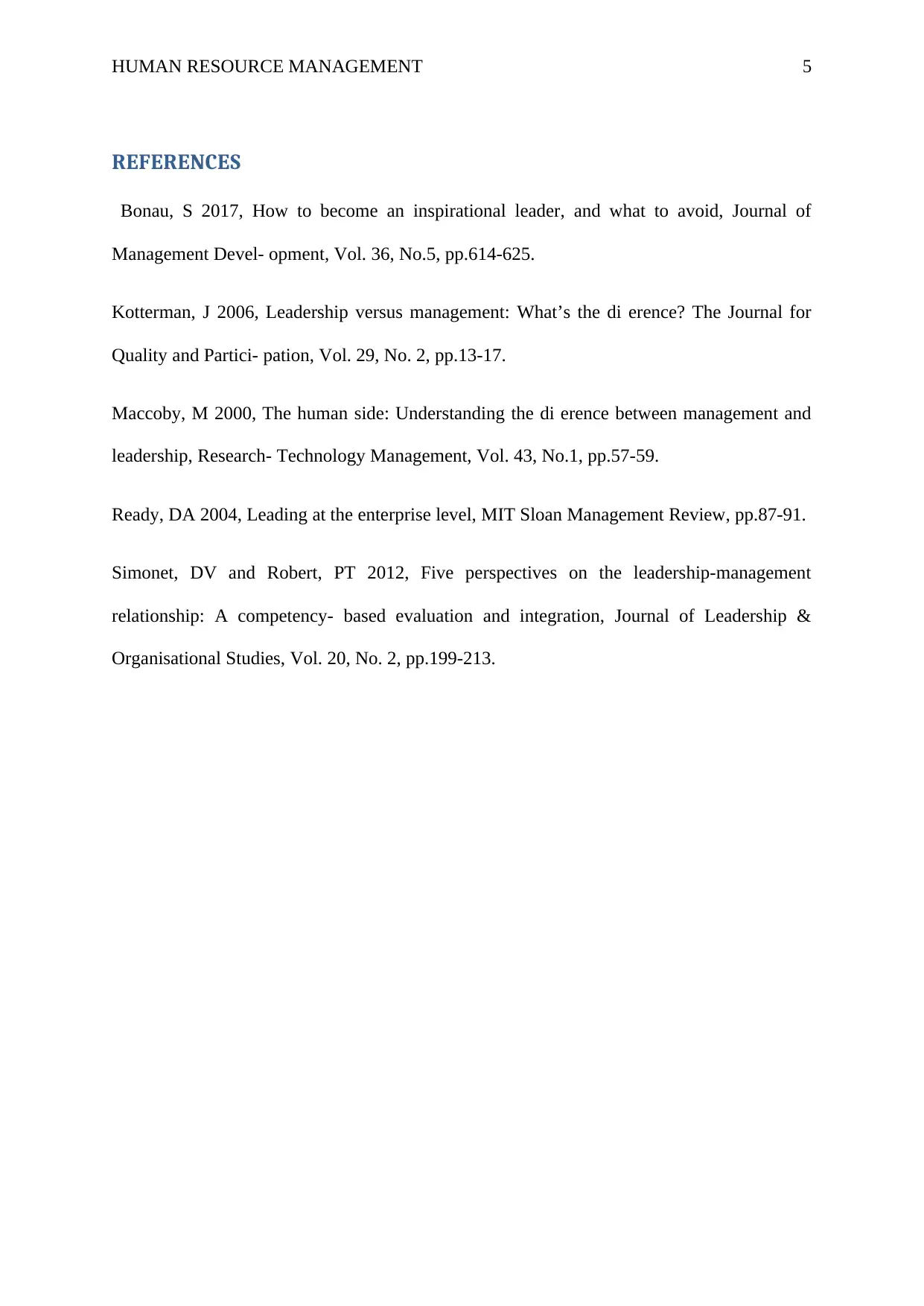
HUMAN RESOURCE MANAGEMENT 5
REFERENCES
Bonau, S 2017, How to become an inspirational leader, and what to avoid, Journal of
Management Devel- opment, Vol. 36, No.5, pp.614-625.
Kotterman, J 2006, Leadership versus management: What’s the di erence? The Journal for
Quality and Partici- pation, Vol. 29, No. 2, pp.13-17.
Maccoby, M 2000, The human side: Understanding the di erence between management and
leadership, Research- Technology Management, Vol. 43, No.1, pp.57-59.
Ready, DA 2004, Leading at the enterprise level, MIT Sloan Management Review, pp.87-91.
Simonet, DV and Robert, PT 2012, Five perspectives on the leadership-management
relationship: A competency- based evaluation and integration, Journal of Leadership &
Organisational Studies, Vol. 20, No. 2, pp.199-213.
REFERENCES
Bonau, S 2017, How to become an inspirational leader, and what to avoid, Journal of
Management Devel- opment, Vol. 36, No.5, pp.614-625.
Kotterman, J 2006, Leadership versus management: What’s the di erence? The Journal for
Quality and Partici- pation, Vol. 29, No. 2, pp.13-17.
Maccoby, M 2000, The human side: Understanding the di erence between management and
leadership, Research- Technology Management, Vol. 43, No.1, pp.57-59.
Ready, DA 2004, Leading at the enterprise level, MIT Sloan Management Review, pp.87-91.
Simonet, DV and Robert, PT 2012, Five perspectives on the leadership-management
relationship: A competency- based evaluation and integration, Journal of Leadership &
Organisational Studies, Vol. 20, No. 2, pp.199-213.
⊘ This is a preview!⊘
Do you want full access?
Subscribe today to unlock all pages.

Trusted by 1+ million students worldwide
1 out of 6
Your All-in-One AI-Powered Toolkit for Academic Success.
+13062052269
info@desklib.com
Available 24*7 on WhatsApp / Email
![[object Object]](/_next/static/media/star-bottom.7253800d.svg)
Unlock your academic potential
Copyright © 2020–2025 A2Z Services. All Rights Reserved. Developed and managed by ZUCOL.


